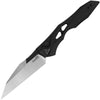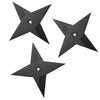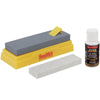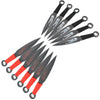Your cart is empty.
How to Start and Build a Case Knife Collection

Back in 1889, four brothers dared to make their own knives and sold them out of a wagon while traveling through small villages in New York. Now, 125 years later, the company that bears their name continues crafting high-quality knives that captivate people from all over the world. That company is W.R. Case & Sons Cutlery Company.
Because of the longevity of this decidedly American institution, Case Knives is widely respected and revered among knife enthusiasts, especially knife collectors. In fact, Case may be one of the most collected knife brands ever.
Collecting Case knives (and knives in general) is a fun and rewarding hobby, but it can be somewhat overwhelming to jump in to. To help set you on your path to building an impressive Case knife collection, we've assembled this guide.
Why Should You Collect Case Knives?

While it's possible to collect a wide range of brands or styles of knives, collecting Case knives is a tradition almost as old as Case itself. In the late 19th century, Case began using a unique stamp dating system that helped spark the desire to collect and it's only become more widespread since then.
Because the institution of collecting is already in place for the brand, it's easier for beginners to jump in. There are so many resources out there for amateur and expert collectors, so you may not feel as stranded as you might be collecting a brand like Scorpion Knives, which is even older but doesn't have the same fanaticism behind it as Case.
Case also has a long and storied history with 125 years of knives, meaning you'll never run out of knives to desire.
The Best Way to Start? "Focus, Focus, Focus"

We're stealing part of the subhead from an article by Case itself, but the advice was too on point to pass up. It's a quote from renowned Case collector Bob Wurzelbacher, giving his best insight for where a beginner should start.
Since Case has been around for 125 years, the company has developed hundreds and hundreds of different knives. A beginner might feel overwhelmed at the prospect of starting off, so it'll make your life significantly easier to focus on one specific attribute. That way your collection won't be all over the place.
By focusing on one aspect, you'll be able to better organize your want lists and make your collecting more efficient. We'll cover the different areas of focus in the next section
Options for Where to Start
If you're interested in starting a collection, focus on one of the following aspects:
- Pattern
- Handle material
- Limited editions
- Licensed knives
- First run production knives
Here's a little more about each.
Pattern
A common way to narrow your collecting scope is to focus on one pattern. We won't go over all the patterns because hundreds have been produced over Case's history, but here's a partial list of some of the most popular patterns: Stockman, Peanut, Copperhead, Barlow, Congress, Elephant Toe, Trapper, Canoe, Bowie, Muskrat, Jack Knife, Whittler, Pruner, Sodbuster, and Folding Hunter.

The key is to pick a pattern you really enjoy. If you find the Sowbelly draws you in more than others, then start there. Your interest and desire to acquire that pattern will help your collecting feel more organic and less forced. If you start off collecting the Teardrop but simply don't like the way it looks, you won't be inclined to continue.
Starting off with newer patterns like the Russlock will help you complete a collection and keep up with new releases. Otherwise, you'll be collecting Trappers forever.
Handle
Another way to collect is by targeting a handle material. You could opt for a certain type of bone handle or something more exotic like Mother-of-Pearl. Here's a partial list of handle materials used by Case: stag, bone, synthetic, abalone, Micarta, celluloid, and various woods.

Before venturing into a handle material, you may want to consider your price range. For example, knives with handles made of mammoth ivory will cost significantly more than knives with smooth synthetic handles.
Within this category, you can also collect different types of jigging patterns, which is when a bone handle is cut in a certain way to form a distinctive appearance and feel. Some of the jigging patterns are Peach Seed, Crow's Feet, Heritage, Impala, Rogers, and Standard.
Once you pick a handle material, the idea is to get that same material in different patterns.
Limited Editions

A third way people collect Case knives is by focusing on Limited Editions. Case frequently puts out knives in limited qualities with numbers on them up to a predetermined production quota, which is usually around 3,000 or less. There are currently more than a dozen knives in the XX Limited Edition Series, which was introduced in 1995, and more are slated to come.
Licensed Knives

We wrote about Case and Harley-Davidson teaming up to create licensed knives, which is another example how people collect. Licensed knives are created when Case collaborates with another company or organization to design exclusive knives that bear the name of the other entity.
A few of the organizations you can find official Case knives for are John Deere, Ford, and the Boy Scouts of America. You can even find official Case knives for John Wayne, Johnny Cash, Dale Earnhardt Jr., and Elvis Presley. This is a particularly fun way to collect Case Knives because having the same licensed knife in every pattern makes a collection look great.
First Production Run
Some people prefer getting a first production run knife, meaning it has a numbered stamp on the blade that indicates it was part of the first batch manufactured. The first run numbers vary but they're usually 500 or less. This requires you to jump on new products the moment they come out because, as you might expect, they go very quickly.
Learn to Read Tang Stamps and Pattern Stamps

If you see a knife with the tang stamp to the right, you should be able to tell exactly what year it was made (The answer is 1997). With the code at the bottom of the stamp, you should be able to tell the handle material, pattern style and number of blades. It might seem daunting at first, but Case has made it easy to identify years and patterns of knives with a code. Learning the code will make identifying and searching for those wishlist knives significantly easier.
The fact that Case made it easy to ID knives from the tang stamps is one of the reasons people love collecting them. In certain decades, the stamp features 10 dots or stars and one is removed each year. Case has this laid out for you in the education portion of their site so you can easily ID the tangs.
As for the pattern stamp, the numbers are written in a specific order to help you know all about the knife. The first number indicates the type of handle material used, the second is the number of blades on the knife, and the last number is the pattern style. These numbers become intuitive after some studying of the handle codes and pattern codes.

Make Your Lists
When you've decided how you want to collect, it makes life easier to create a want list. That'll keep you focused and give you the satisfaction of crossing out things you buy. Your want lists should be centered around the type of pattern, handle, or style you're starting out with. Pick a range of knives that you like the look of or would have fun pursuing within your collection guidelines.
Connect with Collectors

If you're jumping into the hobby, it's never fun doing it alone. In fact, it's darn near impossible to build your collection alone. A great way to expand your collection (and enjoyment) is to attend knife shows or swap meets to talk to your fellow collectors. Not only will they give you insight and knowledge about Case knives but they will also be able to point you to auctions and dealers.
An easy place for beginners to start is the Case Collectors Club. Membership gets you a subscription to the quarterly The Case Collector magazine, access to an online community, and alerts about exclusive promotions.
Learn to Clean Case Knives
Sometimes, when you get that rare knife at a yard sale, you need to restore it to its former glory. A used knife can often benefit from a thorough cleaning. We have some fantastic knife care and maintenance tips or you can head over to Case's site for some other knife care recommendations.
If there's rust on the knife, we wrote a nice blog post about how to remove the rust from your blade by using rust remover like WD-40 or white vinegar.
Properly Store or Display Your Knives

Amassing a collection is only half the battle. Once you have a few knives under your belt, proper storage and displaying is key for maintenance. You don't want your knives accumulating dust or getting rusty, so you should consider two options. The first is an actual Case display box. These typically have a glass window where you can see all the knives you have.
A second option is for a regular knife storage case or knife bag. These won't necessarily display your knives openly, but it will keep them clean and hidden away. If you have hundreds of knives, you may not want them all out for the world to see. Knife rolls also make it easier to carry your collection places.
Don't Forget to Have Fun
There's no real wrong way to collect, so you shouldn't be too rigid in your collecting techniques, but you should heed one important piece of advice: have fun. There's a huge difference between being frustrated about not finding a certain knife and downright hating knife-collecting. Some frustration is to be expected throughout your collecting, but it should never feel burdensome.
Make sure you're having fun because if you don't enjoy it, there are so many other hobbies you could take up… like knife throwing.
Check out our selection of Case knives to help get your collection on its way.

















































![[Open Box: Not Original Packaging] KA-BAR Wood-Base Dome Presentation Case](http://knife-depot.com/cdn/shop/files/383217_{width}x.jpg?v=1682543200)









